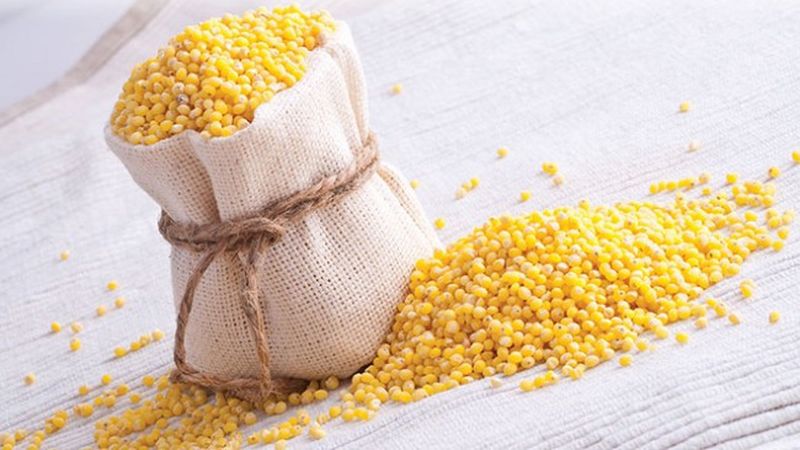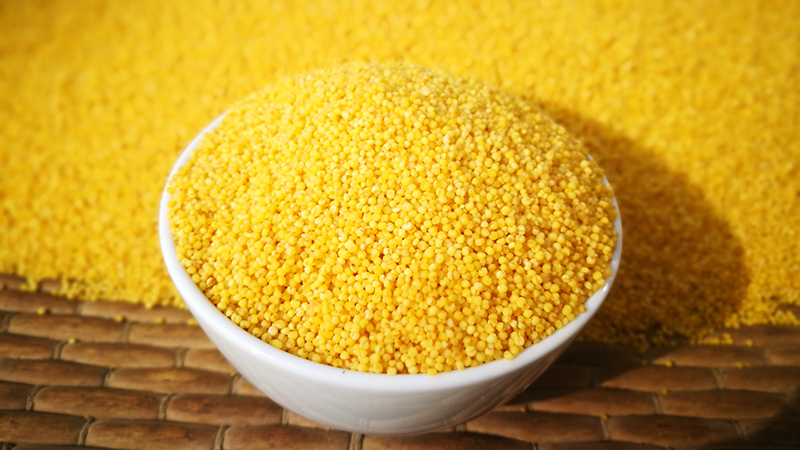The composition and useful properties of millet (millet)
Millet contains a number of vitamins and minerals, thanks to which the product is actively used in alternative medicine and cosmetology. Despite the high calorie content, millet promotes weight loss. At the same time, it is not recommended to abuse them, so as not to earn digestive problems.
Read about the benefits and harms millet brings, what medicinal properties it has - read the article.
The content of the article
Calorie content and chemical composition of millet, vitamins
Millet has a high energy value - up to 342 kcal per 100 g of product. It contains 11.5 g of protein, 66.5 g of carbohydrates and 3.3 g of fat.
The composition of cereals includes nutritional components:
- 9% vegetable fiber;
- essential amino acids - leucine, aspartic acid, threonine;
- vegetable proteins prolamins and glutelins;
- minerals - magnesium, copper, fluorine, iron and manganese;
- 2% sugars;
- vitamin B group - thiamine, riboflavin, pantothenic and nicotinic acids.

Does it contain gluten
Not included in millet gluten - storage proteins found in some cereals. Therefore, cereals can be freely consumed by people with an individual intolerance to this compound, following a gluten-free diet.
Does it contain starch
Groats contain about 66.5% carbohydrates, most of which are starch... Only 2% are easily digestible structures. Starch is composed of amylose and amylopectin, which are partially degraded by saliva and hydrochloric acid in the stomach.
Reference. Due to the high starch content during cooking, millet grows in size, absorbing liquid. Due to this effect, when it enters the stomach, the swollen croup presses on the walls of the organ, causing a feeling of satiety.
What cereal is millet obtained from
Millet is millet seeds, so it is wrong to assume that these are different plants.
There are about 400 varieties of millet and are grown on a large scale for getting millet groats.
There are 3 types of grains:
- millet-shingle is whole grains, freed from the flower film;
- crushed groats - a by-product of the food industry;
- polished millet - kernels of grains, freed from the outer shell, due to which they cook faster and are much easier absorbed by the body.
Beneficial features
What is useful millet and what effect it has on the body:
- The product is rich in vitamins and minerals. Due to the high content of nutrient compounds, millet has a general strengthening effect on the body, accelerates metabolism, improves blood circulation and tissue regeneration.
- Minerals strengthen the bone structure of the musculoskeletal system, improve the contractility of skeletal muscles and myocardium. Plant proteins are used to build new muscle tissue. As a result, the body's endurance increases.
- The high content of coarse and soluble fiber improves the functioning of the digestive tract. Dietary fiber removes toxins, excess fluid and toxic substances from the intestines. Due to its coarse structure, fiber causes an increase in the peristalsis of the smooth muscles of the digestive organs, which has a positive effect on the process of defecation.
- With regular use, cereal reduces the level of harmful cholesterol in the blood serum, preventing the development of atherosclerosis. Organic acids as part of the product improve the rheological properties of blood (viscosity and fluidity). Millet stabilizes the plasma glucose concentration in the body.
- Millet has a diuretic effect, therefore, when used, the body leaves the salts of heavy metals, uric acid, excess minerals. Reduces the risk of urolithiasis.
- Millet contains lipotropic compounds involved in the destruction of adipose tissue. Therefore, cereals are recommended to be eaten during weight loss. If you follow a low-calorie diet, a nutritious product will not only give you vigor and strength, but also help in the fight against excess weight.
Cereals contain a number of polyphenols. Chemical compounds suppress the activity of enzymes that can provoke clouding of the transparent media of the eye. Thanks to this effect, the risk of developing cataracts is reduced.
Application in traditional medicine

Millet is used in folk medicine to improve the general condition of the body. Cereal culture helps with the following diseases and conditions:
- frequent constipation;
- dropsy;
- prevention of kidney and bladder stones;
- increased regeneration of tissues, broken bones, damaged ligaments;
- atherosclerosis;
- diabetes;
- prevention of cancerous degeneration of cells with the subsequent development of malignant neoplasms;
- liver and kidney disease;
- pancreatitis.
However, when using folk remedies, one cannot refuse the main treatment with medicines, since millet does not possess pharmacological properties.
Recommendations for the use of millet for various diseases are presented in the table.
| Disease | Folk remedy recipe |
| Diabetes | The groats are washed with cold water and allowed to dry on a towel. After that, the product is immersed in boiling water, boiled for half an hour, left in hot water for 3 hours. Then the liquid is filtered. Drink 150 ml 3 times a day on an empty stomach between meals. |
| Kidney problems | 250 g of cereals are washed, poured into a glass container and poured with hot water. Cover the dishes with a towel and infuse for 24 hours. After it is filtered and a liquid with a white precipitate is obtained. They drink it in any quantity. |
| Pancreatitis | 200 g of millet is washed and dipped in 2 liters of boiling water. After cooking, 300 g of grated pumpkin is mixed with cereals and boiled for another 15 minutes, 20 g of butter are added. The finished product is used for dinner. |
| Prevention of tumors | 1 tbsp. l. millet is poured with 500 ml of water, brought to a boil and boiled for another 15 minutes. After that, the mixture is infused for 2 hours in a warm place. The filtered broth is drunk 3 times a day, 100 ml each. |
Application in cosmetology
The characteristics of millet allow it to be used as an effective cosmetic product that is easy to prepare at home.
For hair
Millet groats prevent flaking of the scalp, which is why cereals are considered an effective product in the fight against dandruff. To prepare the mask you will need:
- 2 tbsp. l. millet flour;
- 1 tsp olive oil;
- egg yolk;
- green tea extract.
All ingredients are mixed until smooth. The composition is evenly applied to the scalp, covered with cling film on top and wait 30 minutes. After that, the hair is washed with shampoo.
Millet hair extract is made using:
- 40 ml of any vegetable oil;
- 30 g of warmed honey;
- 2 tbsp. l. ground millet.
The ingredients are mixed and applied to the hair roots and skin with light massage movements, covered with cling film. The product is washed off only after 60 minutes. The same mixture is used against split ends - apply it to a comb or simply lubricate the ends before bed.
To strengthen the hair roots, the following ingredients are needed to prepare the mask:
- 1 tbsp. l. ground millet;
- 3 drops of eucalyptus and cedar oil;
- 20 g of liquid honey.
The mixture is rubbed into the scalp, a film is applied on top and left for 15 minutes. The product is washed off with shampoo.
For skin
Millet sprouts produce a nourishing face mask. This requires the following ingredients:
- 1 tsp avocado pulp;
- 1 tsp shredded cereal.
The components are mixed until homogeneous, the finished product is applied to the skin of the face and neck. Wait 20 minutes, then wash off with warm water. The vegetable oils contained in the products will protect the skin from flaking.
To improve skin tone and restore the natural elasticity of the epithelium, a mixture of:
- 4 tbsp. l. grape wine;
- 3 tbsp. l. boiled cereals.
The puree mass is applied to the face and left for 15 minutes, then the mixture is removed with a damp cloth. Face masks are done 2 times a week. To obtain the result, apply the product within a month.
Other

Millet grains have anti-inflammatory and antibacterial effects, so they can be used to scrub against acne and blackheads. This will require:
- egg yolk;
- 1 tbsp. l. olive oil;
- 100 g of boiled millet.
The groats are ground in a blender with the addition of a small amount of boiling water to obtain a semi-liquid homogeneous mass. After cooling down, the yolk and vegetable oil are added to the mixture. The resulting scrub is used to treat the skin of the face, avoiding the area around the eyes, 2-3 times a week in the morning and in the evening. The product is applied for 20 minutes, then washed off with soapy water.
In addition to its anti-acne effect, millet slows down the aging process. The active herbal ingredients in cereals enhance the production of collagen and elastin, so that you can get rid of the fine lines of wrinkles in the forehead, mouth and eyes.
To prepare an anti-aging product, you will need the following ingredients:
- 2 tbsp. l. ground cereal;
- 50 ml of strong black tea;
- 0.5 tbsp. l. sunflower oil.
All components are thoroughly mixed, applied to problem areas and wait 25 minutes. Then the mask is washed off, and the skin of the face is additionally moisturized with a nourishing cream.
Harm and contraindications
Despite its many beneficial properties, millet can be harmful to the body if used incorrectly.
Product abuse leads to digestive problems:
- increased gas production in the intestines;
- pain in the epigastric region;
- heaviness in the stomach;
- constipation.
The negative effect is due to the high coarse fiber content in millet. Dietary fiber is practically not digested in the stomach, absorbs excess fluid and swells. As a result, the passage of semi-digested food and feces through the intestines slows down, and the peristalsis of smooth muscles increases.
Attention! Due to its high carbohydrate content, eating a lot of millet can lead to excess weight. This is a high-calorie product: people with obesity are not recommended to eat cereals.
Millet is contraindicated in the following cases:
- diseases of the gastrointestinal tract - gastritis, ulcerative lesions, gastroenteritis, increased acidity of gastric juice, frequent heartburn, stool disorders;
- individual intolerance to the product;
- thyroid disease;
- the period of treatment with antibacterial drugs - millet accelerates the excretion of active substances, reducing the therapeutic effect of medicines.
It is not recommended to use millet groats together with products containing iodine. Cereals prevent the absorption of this element in the intestines.
Conclusion
For maximum benefit, do not consume more than 150 g of millet per day and eat it more than three times a week. To improve the digestion process, the product is eaten in the morning, because an evening meal can lead to heaviness in the stomach.
Correct intake of the product will provide the body with energy, slow down the development of chronic diseases and improve metabolism.